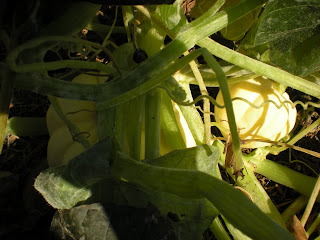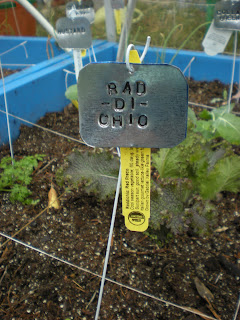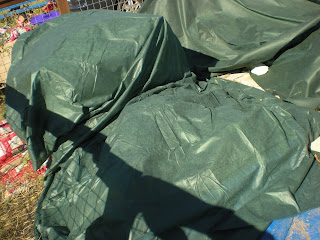Playing catch up on the blog. It’s late January, 2010, and I’m filling in captions and notes for draft entries for months past. Cheers!We had a nasty, early freeze. I didn't get all of my plants covered in time. I had fully planned to, and then failed. These following images include plant carnage, and may not be suitable for all viewers. Discretion is advised. Froze globe basil...
Froze globe basil... Froze zinnias...
Froze zinnias... Rags thrown over squash and gourds, to no avail. Insert sad face here.
Rags thrown over squash and gourds, to no avail. Insert sad face here.
 Oh, the carnage. So, so, SOOO sad.
Oh, the carnage. So, so, SOOO sad.

I found half a dozen or so pumpkins and acorn squash as I sifted through the freeze-damaged vines.

Acorn squash...

Some white mini pumpkins...

I took all of my pumpkins and squash to Houston for Thanksgiving and we used them for centerpieces. Once back home in Austin, I let them ripen more in the kitchen. Eventually they got carved, seeded, roasted and pureed and made into some awesome muffins.

This was my sun-gold cherry tomato bush. Man, those things were delicious. I hated seeing this thing die.

Yep, you guessed it! This is THE bed. Since it's somehow finding its way into every post, I'm going to start hiding weird things in it. The first person who posts a comment to the blog identifying that week's hidden object by the deadline (I'll put it in the post) will win a handful of what ever is in season!

My "Jack-O-Lantern" vine, decimated. But the pumpkin didn't die!

Thank goodness for cold weather veggies! My brassicas did great.

As did most of my herbs.

My "Caprese" bed didn't fare as well, but I wasn't thinking it would. I needed the freeze damage to encourage me to clean out the bolted basils and the hopeless 'maters and peppers and put in something that would do better in the cold.
 The wilted marigolds were heartbreaking. What was a firey mound of orange and yellow just a few days before turned into a sad puddle of deadness.
The wilted marigolds were heartbreaking. What was a firey mound of orange and yellow just a few days before turned into a sad puddle of deadness.
 I had tried to use these army green frost covers, but they weren't all that helpful. I thought these covers were supposed to insulate, not just keep frost from touching plants. Apparently, I misunderstood the packaging.
I had tried to use these army green frost covers, but they weren't all that helpful. I thought these covers were supposed to insulate, not just keep frost from touching plants. Apparently, I misunderstood the packaging. Blobby frost cover messiness.
Blobby frost cover messiness.I was VERY happy with these. My original plan was to use them to hold up the green frost cloth for future cold snaps, and if necessary, layer warmer blankets on top. I eventually found a better product though, and the green frost covers got relegated to the back yard plants. Pics of and info on the better product to come.








































